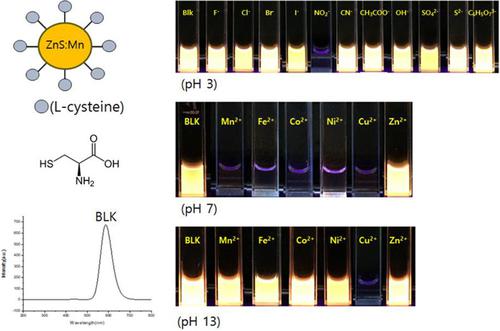当前位置:
X-MOL 学术
›
Bull. Korean Chem. Soc.
›
论文详情
Our official English website, www.x-mol.net, welcomes your
feedback! (Note: you will need to create a separate account there.)
Variable Sensing Ion Selectivity of the l‐Cysteine Capped ZnS:Mn Nanocrystals in Aqueous Solution
Bulletin of the Korean Chemical Society ( IF 2.3 ) Pub Date : 2020-08-20 , DOI: 10.1002/bkcs.12079 Mi Choi 1 , Cheong‐Soo Hwang 1
Bulletin of the Korean Chemical Society ( IF 2.3 ) Pub Date : 2020-08-20 , DOI: 10.1002/bkcs.12079 Mi Choi 1 , Cheong‐Soo Hwang 1
Affiliation

|
Colloidal l‐cysteine (Cys)‐capped ZnS:Mn nanocrystals were synthesized and exposed to various pH conditions to modify their surface for further applications as photo‐chemical sensors. The observed zeta‐potential values indicated that the ZnS:Mn–Cys nanocrystals formed positive charged nanocrystal surface at pH 3 condition. Therefore, they were considered to be applied as an anion sensor. As a result, the fluorescence of the ZnS:Mn–Cys‐pH 3 nanocrystals was exclusively quenched by the addition of nitrite (NO2−) ions. In addition, the ZnS:Mn–Cys nanocrystals, which were exposed to pH 7 and pH 13, formed negatively charged surfaces, which were presumed to be applied as cation photosensors. Consequently, the fluorescence of the ZnS:Mn–Cys‐pH 7 nanocrystals were amplified by the addition of Zn2+ ions, whereas the most added metal ions caused quenching of the emission lights of the ZnS:Mn–Cys‐pH 7 nanocrystals. Moreover, the fluorescence of the ZnS:Mn–Cys‐pH 13 nanocrystals was quenched only when Cu2+ ions were added.
中文翻译:

半胱氨酸封端的ZnS:Mn纳米晶体在水溶液中的可变传感离子选择性
胶体升半胱氨酸(CYS)加帽的ZnS:锰纳米晶体的合成和暴露于各种pH条件以改变其表面,用于进一步的应用作为光化学传感器。观察到的ζ电势值表明,ZnS:Mn–Cys纳米晶体在pH 3条件下形成带正电的纳米晶体表面。因此,认为它们被用作阴离子传感器。其结果是,所述硫化锌的荧光:锰的Cys-pH为3个纳米晶体是专门通过添加亚硝酸盐(NO的淬灭2 -)离子。此外,暴露于pH 7和pH 13的ZnS:Mn–Cys纳米晶体形成带负电的表面,据推测可将其用作阳离子光电传感器。因此,通过添加Zn 2+离子可以放大ZnS:Mn-Cys-pH 7纳米晶体的荧光,而添加最多的金属离子会导致ZnS:Mn-Cys-pH 7纳米晶体的发射光猝灭。此外,仅当添加Cu 2+离子时,ZnS:Mn–Cys-pH 13纳米晶体的荧光才被淬灭。
更新日期:2020-08-20
中文翻译:

半胱氨酸封端的ZnS:Mn纳米晶体在水溶液中的可变传感离子选择性
胶体升半胱氨酸(CYS)加帽的ZnS:锰纳米晶体的合成和暴露于各种pH条件以改变其表面,用于进一步的应用作为光化学传感器。观察到的ζ电势值表明,ZnS:Mn–Cys纳米晶体在pH 3条件下形成带正电的纳米晶体表面。因此,认为它们被用作阴离子传感器。其结果是,所述硫化锌的荧光:锰的Cys-pH为3个纳米晶体是专门通过添加亚硝酸盐(NO的淬灭2 -)离子。此外,暴露于pH 7和pH 13的ZnS:Mn–Cys纳米晶体形成带负电的表面,据推测可将其用作阳离子光电传感器。因此,通过添加Zn 2+离子可以放大ZnS:Mn-Cys-pH 7纳米晶体的荧光,而添加最多的金属离子会导致ZnS:Mn-Cys-pH 7纳米晶体的发射光猝灭。此外,仅当添加Cu 2+离子时,ZnS:Mn–Cys-pH 13纳米晶体的荧光才被淬灭。











































 京公网安备 11010802027423号
京公网安备 11010802027423号